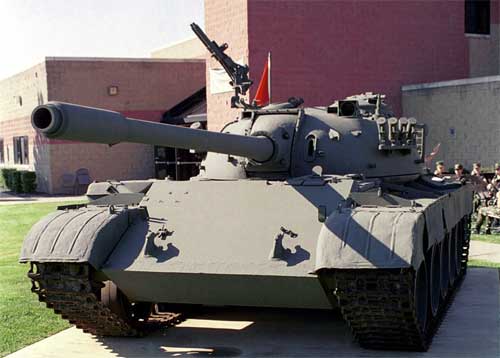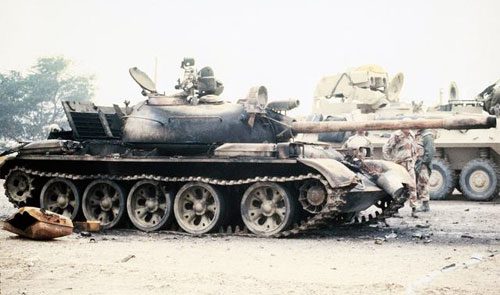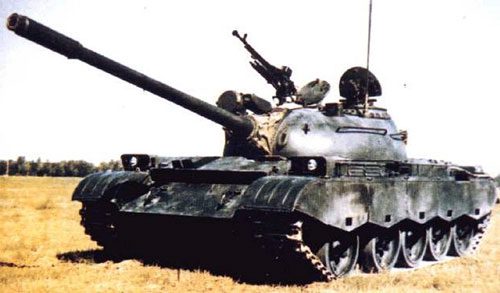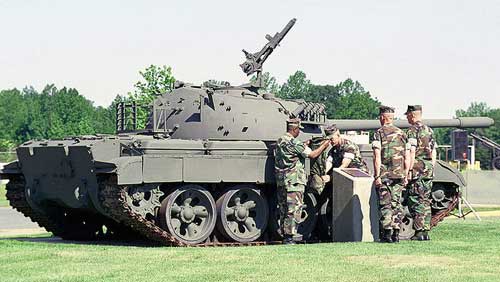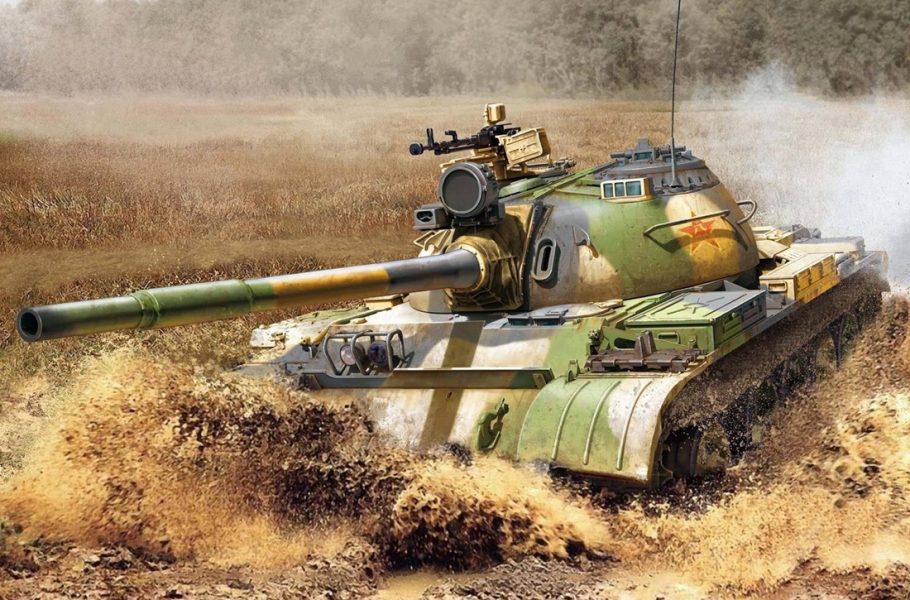
Main battle tank Type 69 (WZ-121)
Content
Main battle tank Type 69 (WZ-121)
Comparative firing tests have shown that 100-mm rifled guns have higher firing accuracy and armor-piercing ability. Initially, about 150 Type 69-I tanks were fired with a 100-mm smooth-bore cannon of its own production, the ammunition of which included shots with armor-piercing sub-caliber, as well as cumulative and fragmentation shells.
Since 1982, a later developed Type 69-I tank has been produced with a 100-mm rifled gun and a more advanced fire control system. The ammunition of this gun includes shots with armor-piercing sub-caliber, fragmentation, armor-piercing high-explosive shells. All shots are made in China. Later, for export deliveries, Type 69-I tanks began to be equipped with 105-mm rifled guns with ejectors shifted two-thirds of the barrel length closer to the turret. The gun is stabilized in two planes, guidance drives are electro-hydraulic. The gunner has a Type 70 telescopic sight, a periscopic day sight with dependent stabilization of the field of view, a separate night sight based on the first generation image intensifier tube with a range of up to 800 m, 7x magnification and a field of view angle of 6 °.
The commander has a Type 69 periscopic dual-channel sight with a night channel on the same image intensifier tube. An IR illuminator mounted on the front of the turret is used to illuminate targets. On the Type 69 tank, a more advanced fire control system, APC59-5, developed by NORINCO, was installed compared to the Type 212 tank. It consists of a laser rangefinder mounted above the gun barrel, an electronic ballistic computer with sensors for wind, air temperature, elevation angles and inclination of the gun trunnion axis, a stabilized gunner's sight, a two-plane gun stabilizer, as well as a control unit and sensors. The gunner's sight has a built-in alignment system. The ARS5-212 fire control system provided the gunner with the ability to hit stationary and moving targets both day and night with the first shot with a probability of 50-55%. According to the requirements of NORINCO, typical targets must be hit by fire from a tank gun for no more than 6 seconds. The laser rangefinder of the Type 69-II tank based on neodymium is fundamentally similar to the laser rangefinder of the Soviet T-62 tank.
It allows the gunner to measure the range to the target from 300 to 3000 m with an accuracy of 10 m. Another improvement of the tank is the installation of a set of firing and observation devices. The commander's observation device has a 5-fold increase during the day, 8-fold at night, a target detection range of 350 m, a field of view angle of 12 ° during the day and 8 ° at night. The driver's night observation device has the following characteristics: 1x magnification, field of view angle of 30 ° and a viewing range of 60 m. When illuminated by a more powerful source of infrared radiation, the range of the device can increase up to 200-300 m. The sides of the hull are protected by folding anti-cumulative screens . The thickness of the frontal hull sheets is 97 mm (with a decrease in the area of the roof and hatches to 20 mm), the frontal parts of the tower are 203 mm. The tank is equipped with a 580-horsepower four-stroke 12-cylinder V-shaped diesel engine 121501-7ВW, similar to the engine of the Soviet T-55 tank (by the way, the Type-69 tank itself practically copies the Soviet T-55 tank).
The tanks have a mechanical transmission, a caterpillar with rubber-metal hinges. Type 69 is equipped with radio station “889” (later replaced by “892”), TPU “883”; two radio stations "889" were installed on command vehicles. FVU, thermal smoke equipment, semi-automatic PPO are installed. On some vehicles, the turret of the 12,7 mm anti-aircraft machine gun is protected by an armored shield. Special camouflage paint ensures its low visibility in the infrared range. On the basis of the Type 69 tank, the following were produced: a twin 57-mm ZSU Type 80 (outwardly similar to the Soviet ZSU-57-2, but with side screens); twin 37-mm ZSU, armed with Type 55 automatic guns (based on the Soviet gun of the 1937 model of the year); BREM Type 653 and tank bridge layer Type 84. Type 69 tanks were delivered to Iraq, Thailand, Pakistan, Iran, North Korea, Vietnam, Congo, Sudan, Saudi Arabia, Albania, Kampuchea, Bangladesh, Tanzania, Zimbabwe. The performance characteristics of the main battle tank Type 69
Sources:
| ||||||||||||||||||||||||||||||||||||||||||||||

 In the early 80s, it became obvious that the Chinese army lagged behind the armies of Western states in terms of the level of development of main battle tanks. This circumstance forced the command of the country's armed forces to speed up the creation of a more advanced main battle tank. This problem was considered as one of the main ones in the general program of modernization of the Ground Forces. The Type 69, a modernized version of the Type 59 main battle tank (outwardly almost indistinguishable), was first shown at the parade in September 1982 and became the first main tank made in China. Its first samples were produced by the Baotou plant with 100mm rifled and smoothbore guns.
In the early 80s, it became obvious that the Chinese army lagged behind the armies of Western states in terms of the level of development of main battle tanks. This circumstance forced the command of the country's armed forces to speed up the creation of a more advanced main battle tank. This problem was considered as one of the main ones in the general program of modernization of the Ground Forces. The Type 69, a modernized version of the Type 59 main battle tank (outwardly almost indistinguishable), was first shown at the parade in September 1982 and became the first main tank made in China. Its first samples were produced by the Baotou plant with 100mm rifled and smoothbore guns.